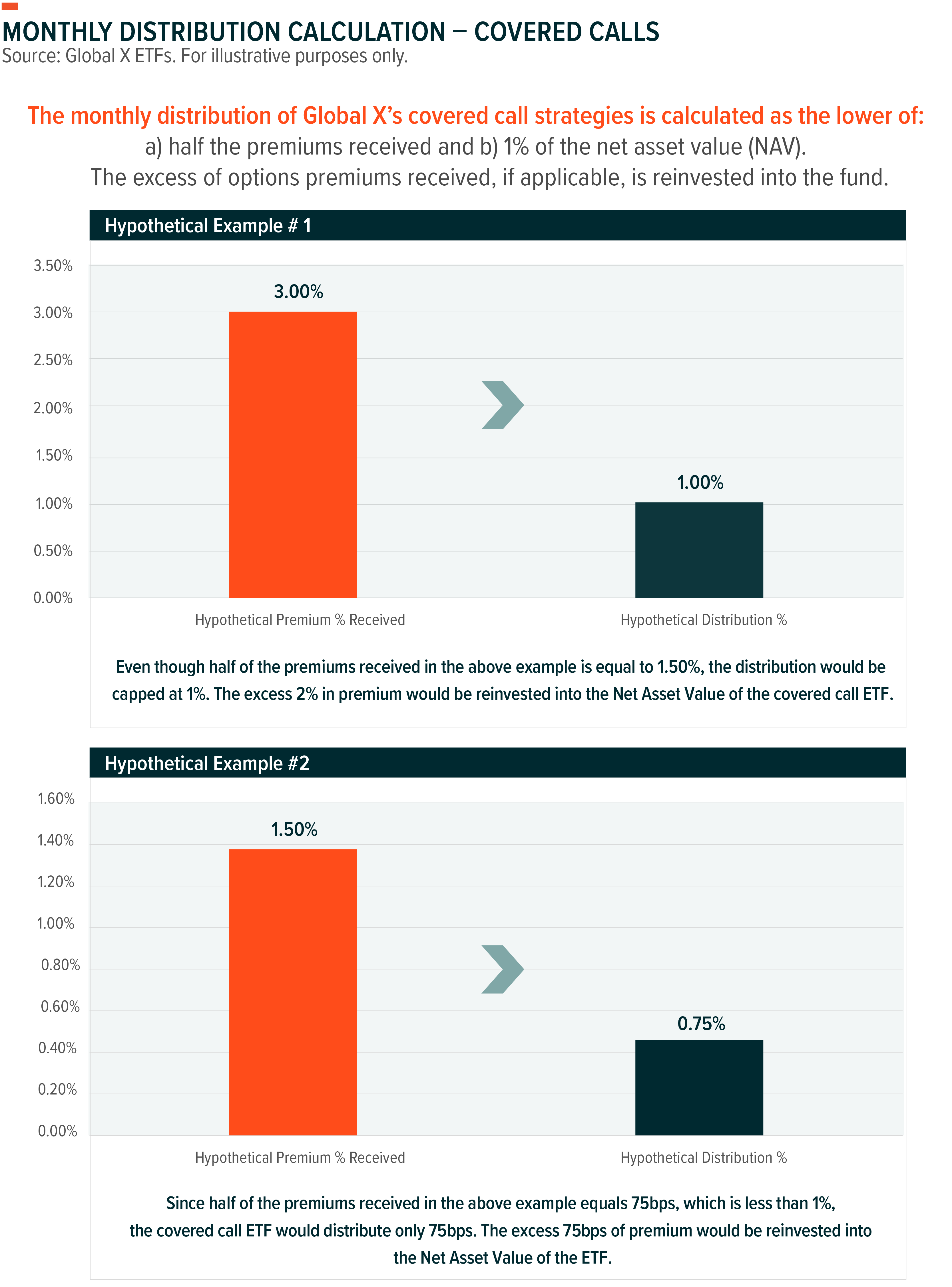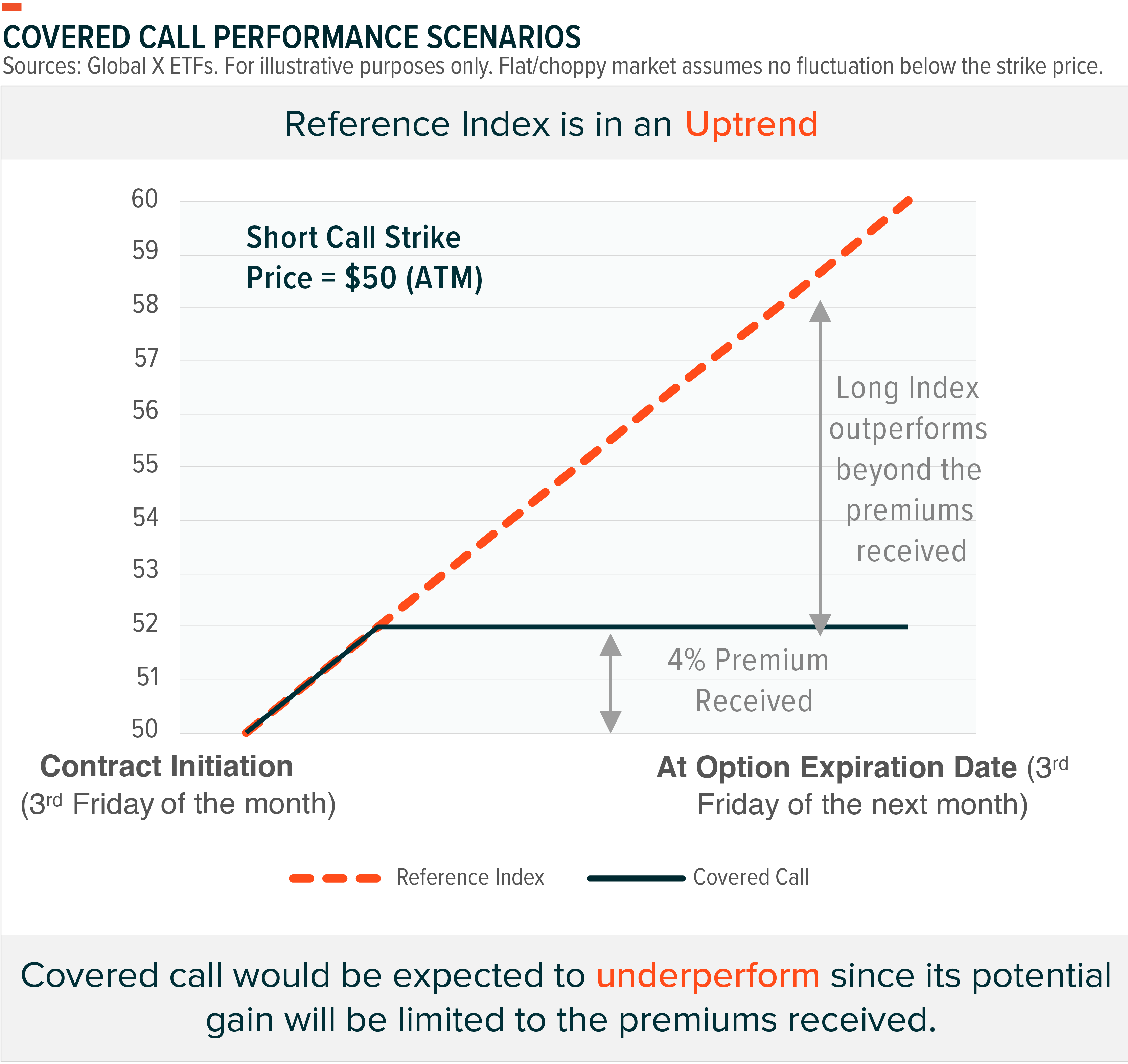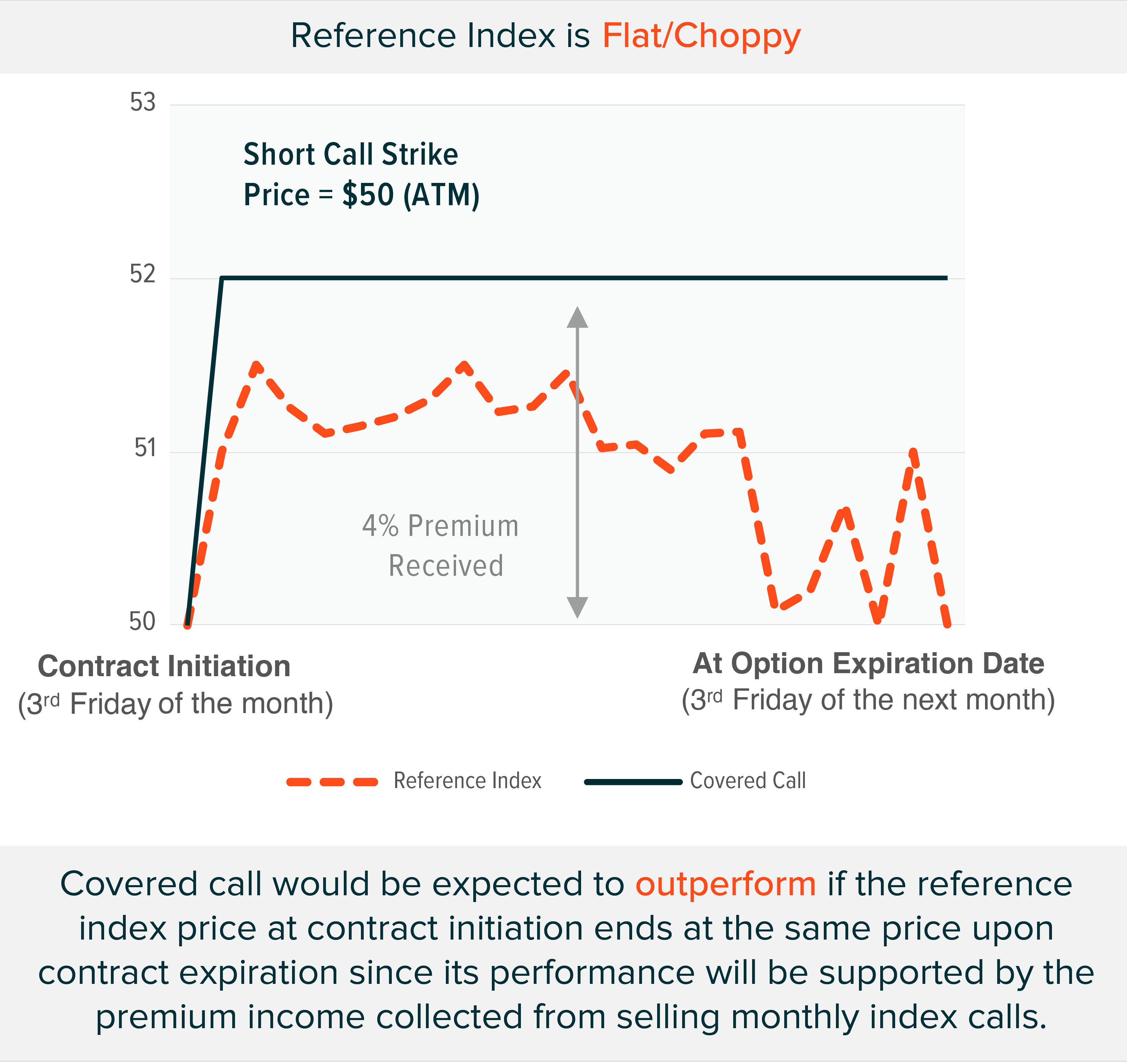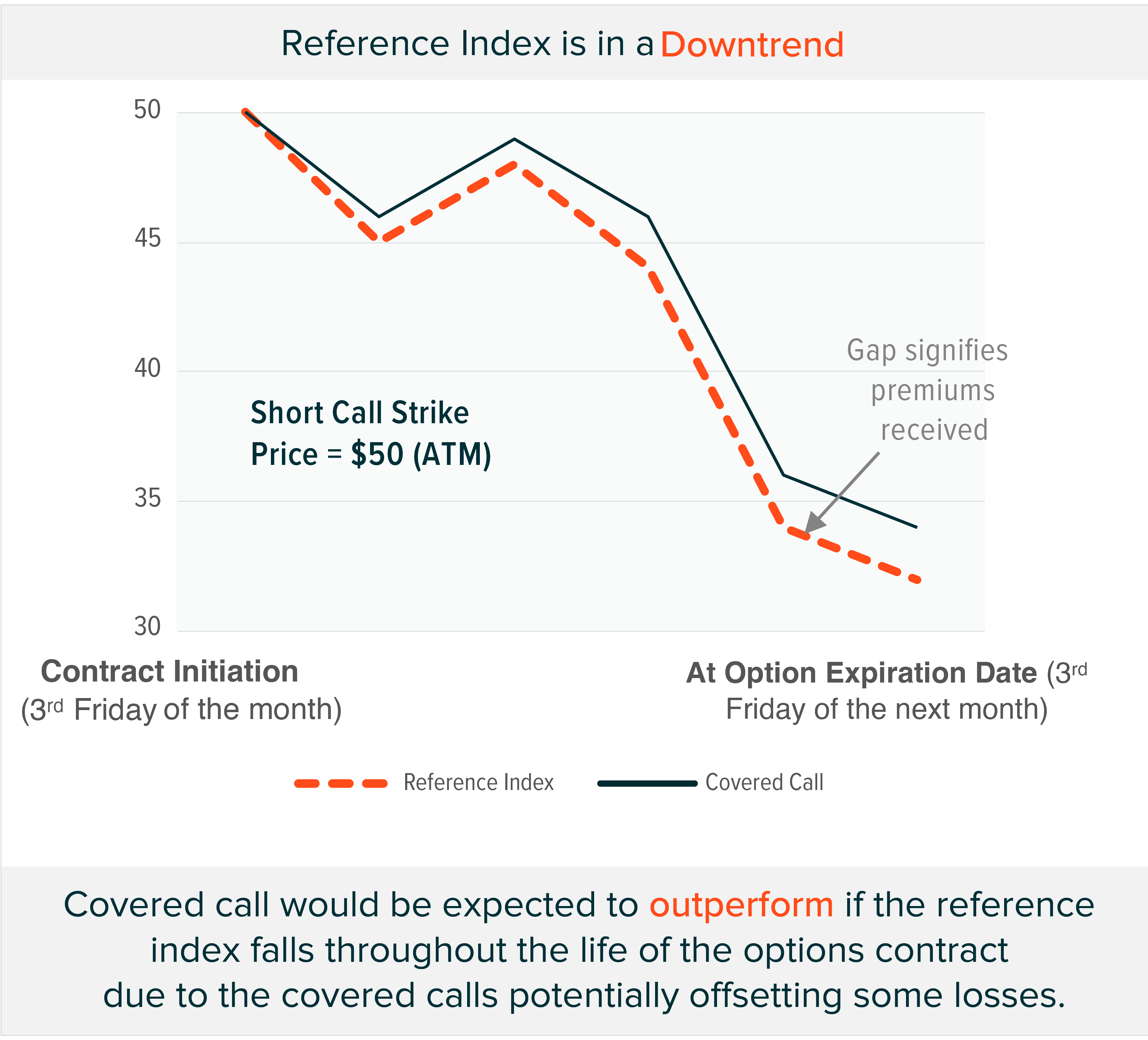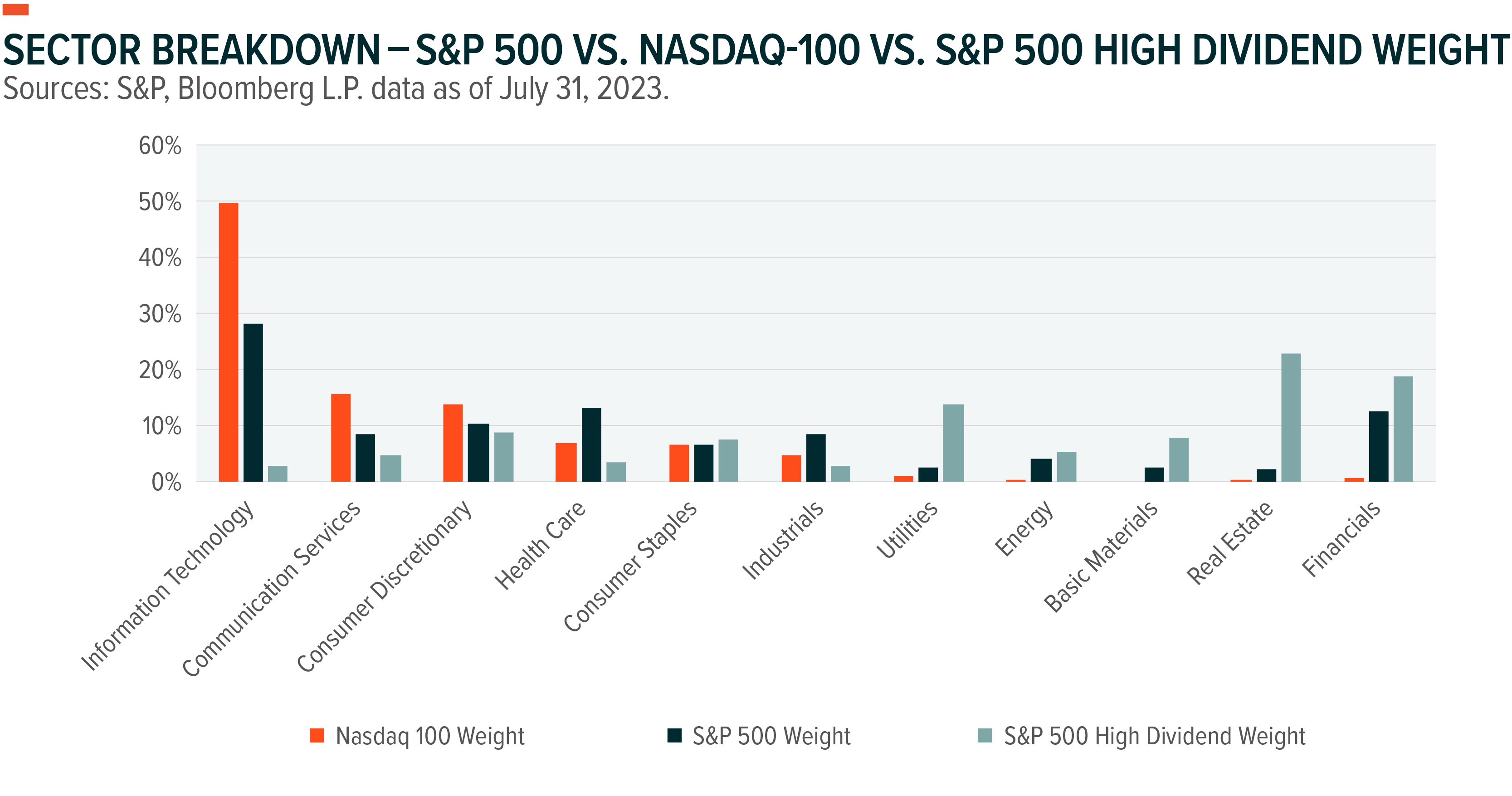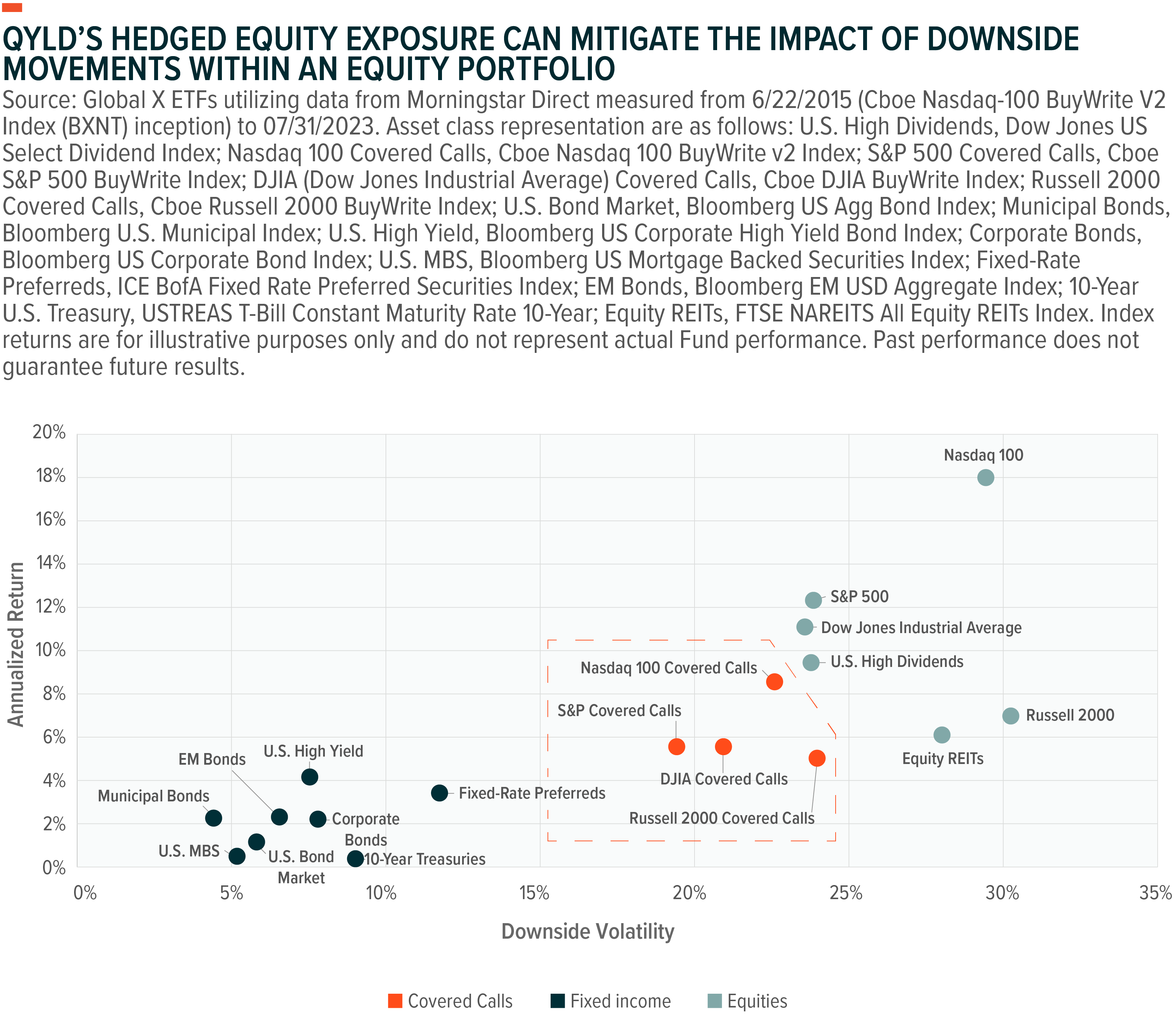At the onset of 2023, a combination of factors dampened investor sentiment as it pertained to U.S. equities. Among them were rising interest rates and recessionary concerns that dented consumer confidence. As the first half unfolded, however, markets found support in the form of decelerating inflation, resilience in jobs reports, and strong positive revenue revisions for major players in the tech space. The breadth of this rally was narrow, driven by a small constituency of mega-cap names in the Nasdaq 100 Index. However, now that share gains have grown more broad based, where markets may go from here and what investors can do in them represent some big questions. In this environment that features higher valuations, covered call option strategies can provide opportunities to hedge positions and generate current income. Among them is the Global X Nasdaq 100 Covered Call ETF (QYLD).
Key Takeaways
- The Nasdaq 100 Index has increased precipitously in value so far this year, but momentum has slowed in recent months, and investors may be looking for a way to hedge their positions.
- The Global X Nasdaq 100 Covered Call ETF (QYLD) is a fully covered buy-write strategy that uses the Nasdaq 100 as its reference asset. Providing a potential stream of premium income, the fund acts as a competitive total return solution that may boost a portfolio’s current yield.
- Covered call investment strategies can bring visibility, a variety of diversification benefits, and risk mitigation potential to a portfolio.
Finding Current Income in the Nasdaq 100
Accounts that maintained a healthy exposure to Nasdaq 100 Index constituents despite all the market uncertainty in early 2023 were well rewarded in the first half. The Communication Services, Consumer Discretionary, and Information Technology sectors, which make up the lion’s share of the index, represented some of the strongest performing segments of the market. In fact, a few participants in these growth focused arenas performed so well that it led to overconcentration in the index and a special rebalance in July, though the Nasdaq 100’s composition is largely the same.
Major advancements in artificial intelligence, cloud computing, and the internet of things offer the potential to push valuations even higher. That said, some investors may be interested in hedging their positions, and they can do so while pursuing a source of current income through a covered call strategy. In the chart below, we highlight some of the more conventional asset classes that investors use to find current yield. We also include the 12-month trailing yield provided by the Global X Nasdaq 100 Covered Call ETF (QYLD). Discounting the competitive income stream that it has provided, the fund also offers exposure to the Nasdaq 100.
Duplicating exposures to Nasdaq 100 constituents might seem counterintuitive at first glance when trying to mitigate risk. However, an at-the-money covered call strategy like QYLD seeks to monetize the index’s volatility to create income that can act as somewhat of a hedge. That potential income can also supplement an existing growth strategy while offering a portfolio a positive relationship with volatility that other investment vehicles may not provide.
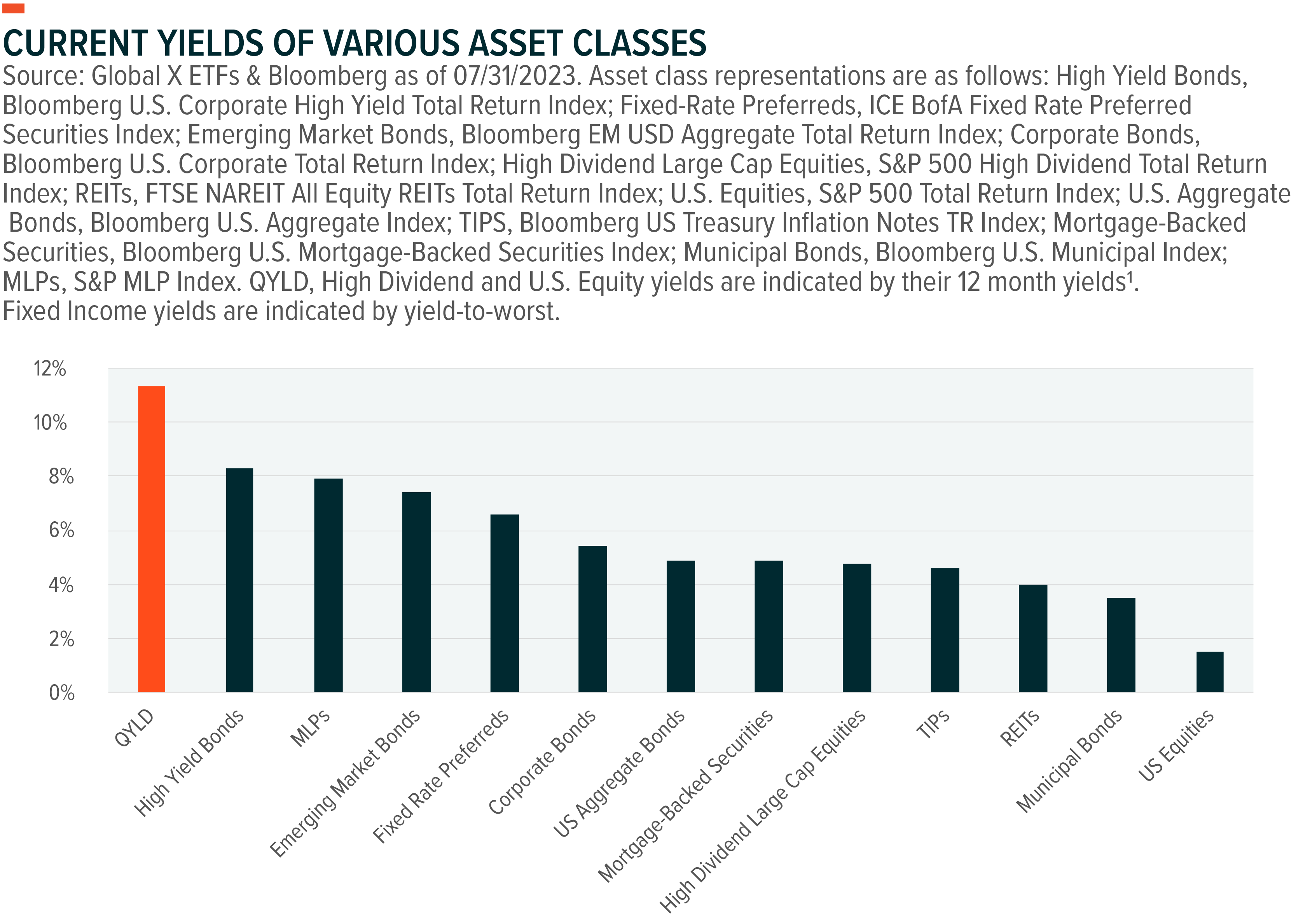
Performance data quoted represents past performance and does not guarantee future results. Investment return and principal value of an investment will fluctuate so that an investor’s shares, when sold or redeemed, may be worth more or less than their original cost. Current performance may be higher or lower than the performance quoted. For performance data current to the most recent month- or quarter-end, 30-Day SEC Yield, and a copy of the fund prospectus, please click here.
Breaking Down QYLD’s Basics
The Global X Nasdaq 100 Covered Call ETF is an index fund that operates a rules-based investment policy, including a covered call option overlay. QYLD’s covered call strategy works in the same way that it might for an individual investor that wants to maintain holdings on a single equity and then write calls on that position to generate income. QYLD simply uses the broader Nasdaq 100 index as its reference asset and writes its call options against the broader index in exchange for the options’ premiums.
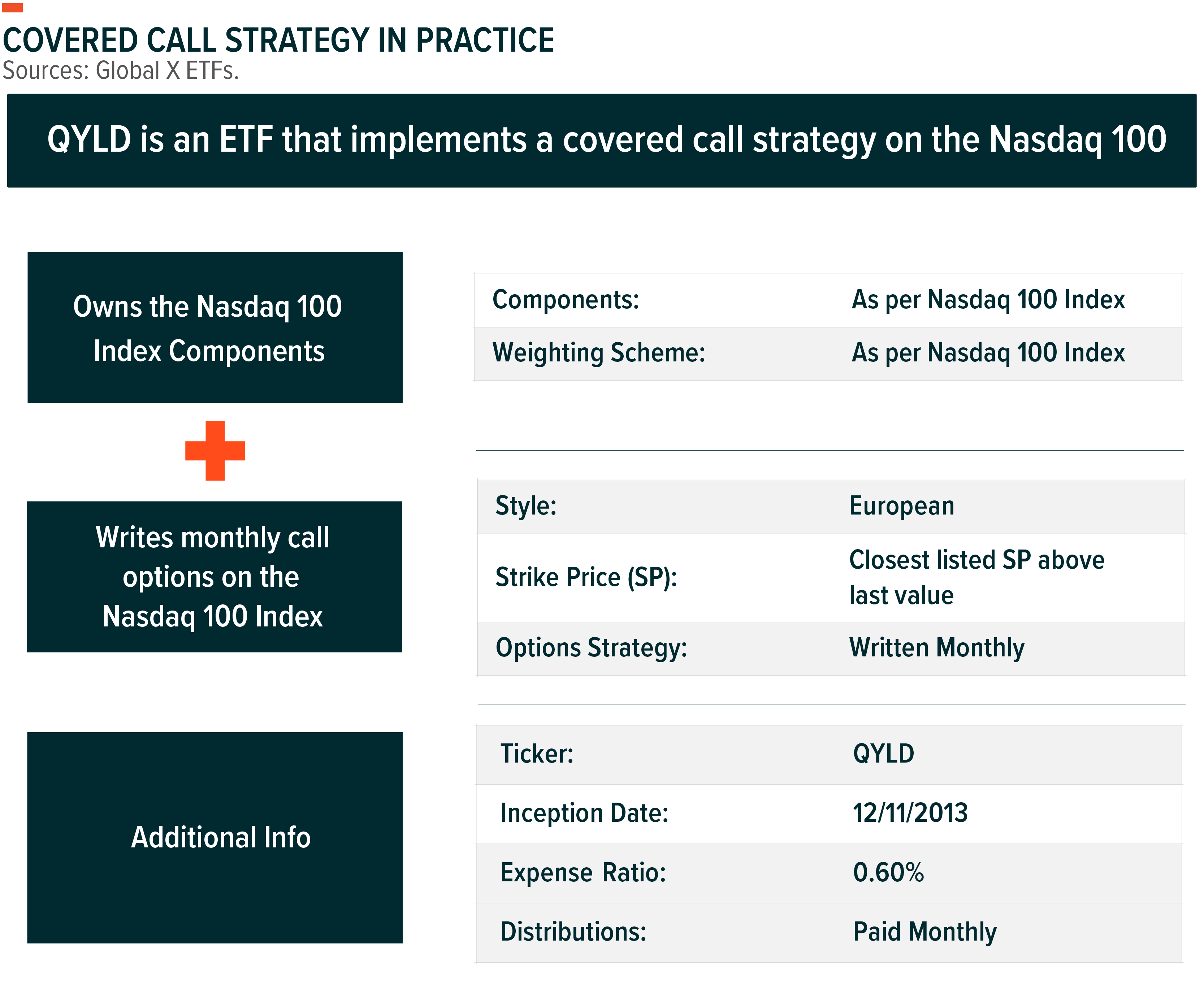
Rather than purchase an ETF that tracks the Nasdaq 100, QYLD purchases the many components that comprise the index. As a result, the fund can maintain a high level of liquidity and it is not subjecting itself to the additional expenses that might be associated with purchasing another ETF. Also, the strategy keeps the fund flexible in that it can purchase or sell the stock of individual companies in order to maintain an overall weighting that is as close as possible to its equity index, the Nasdaq 100. QYLD seeks to provide investment results that correspond generally to the price and yield performance, before fees and expenses, of the Cboe Nasdaq 100 BuyWrite V2 Index.
QYLD operates a call-write strategy to cover 100% of its notional portfolio by selling Nasdaq 100 (NDX) call options that cover the entire Nasdaq 100, as opposed to writing call options on all the stocks that make up the index individually. The fund uses European style options that cannot be executed by the purchaser until the contract reaches its expiration date. These contracts are cash settled, so the fund maintains its systematic approach, writing at-the-money options monthly, and investors do not need to be concerned with how the fund can maintain its holdings at a similar weight to that of the index.
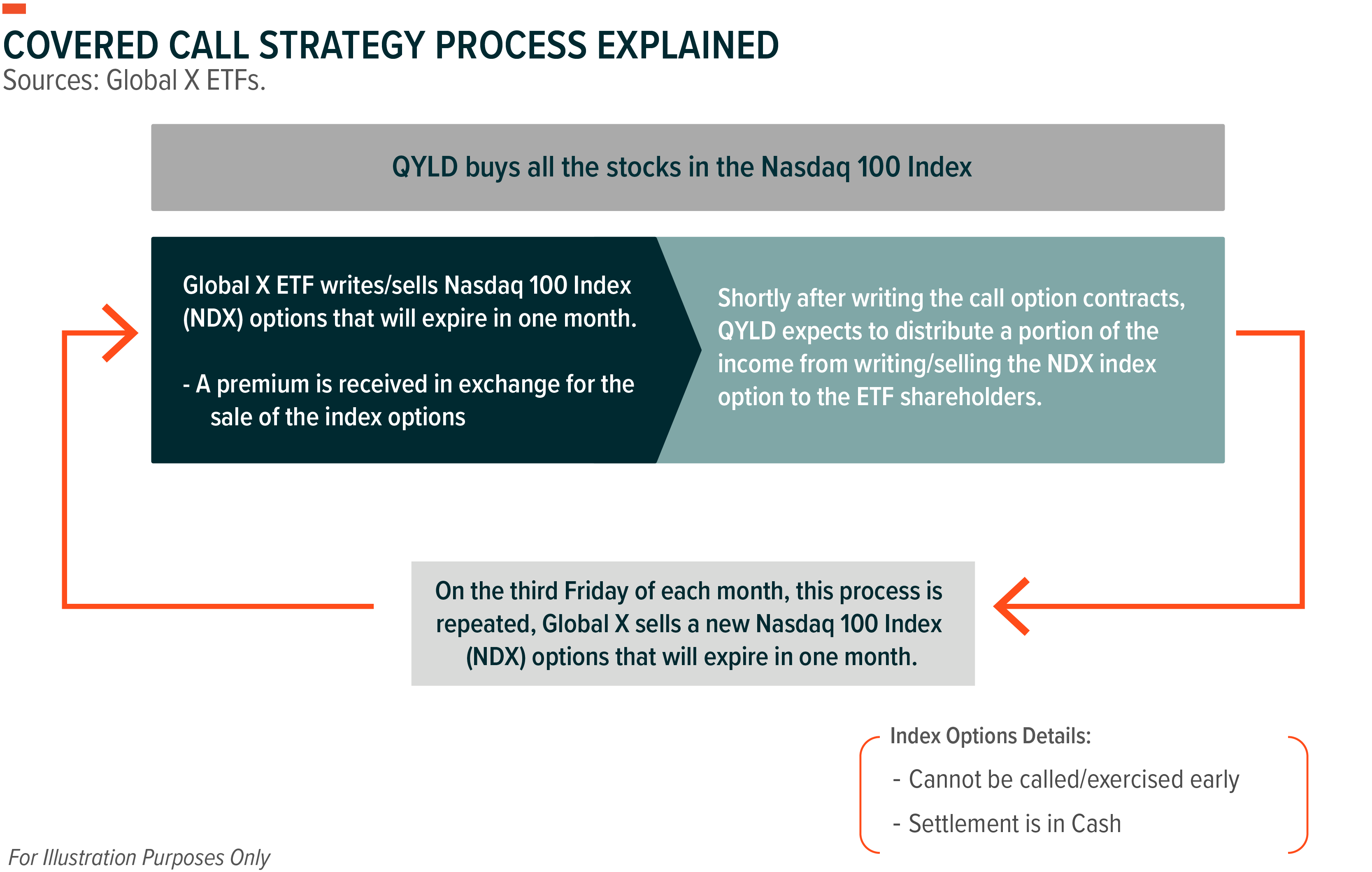
Each month, the Global X Nasdaq 100 Covered Call ETF writes call options with strike prices that are at the money, which means that at initiation the strike price of the calls written is equal to the value of the underlying index. If a contract with a strike price that is precisely at-the-money is not available to be sold, the fund will write its call options at the closest possible strike price to the reference index’s value that is out of the money. The strategy allows the fund to attract the highest possible premiums for its written calls without selling contracts that are already in a position to potentially be exercised. From there, the fund proceeds to implement its distribution policy of distributing half of the premiums it has received or 1% of the fund’s net asset value, whichever is lower. The balance of the premium is reinvested back into the fund.
QYLD Represents a Total Return Solution
Writing index call options against 100% of the value of its portfolio, QYLD forgoes the possibility of realizing the capital appreciation generated by the Nasdaq 100 Index. The fund operates this way so that it can attract the highest possible premiums in exchange for calls written. It then makes its distributions from this stockpile in an effort to produce a competitive yield.
Investors can use the income that may be generated by a position in QYLD at their discretion. That said, this income is oftentimes absent from the fund’s price chart when displayed across various investment research platforms. This undertaking results in QYLD displaying a negative price trend since its inception, as shown in the chart below. However, depending on their needs, we encourage investors to consider the opportunity for reinvestment that exists as a product of the income that QYLD has generated. Indeed, we view QYLD as a total return solution and submit that its performance should be assessed as such. If held since inception and with all distributions reinvested into the fund, an investor’s cumulative total return for QYLD would have been about 95% as of August 31st.2
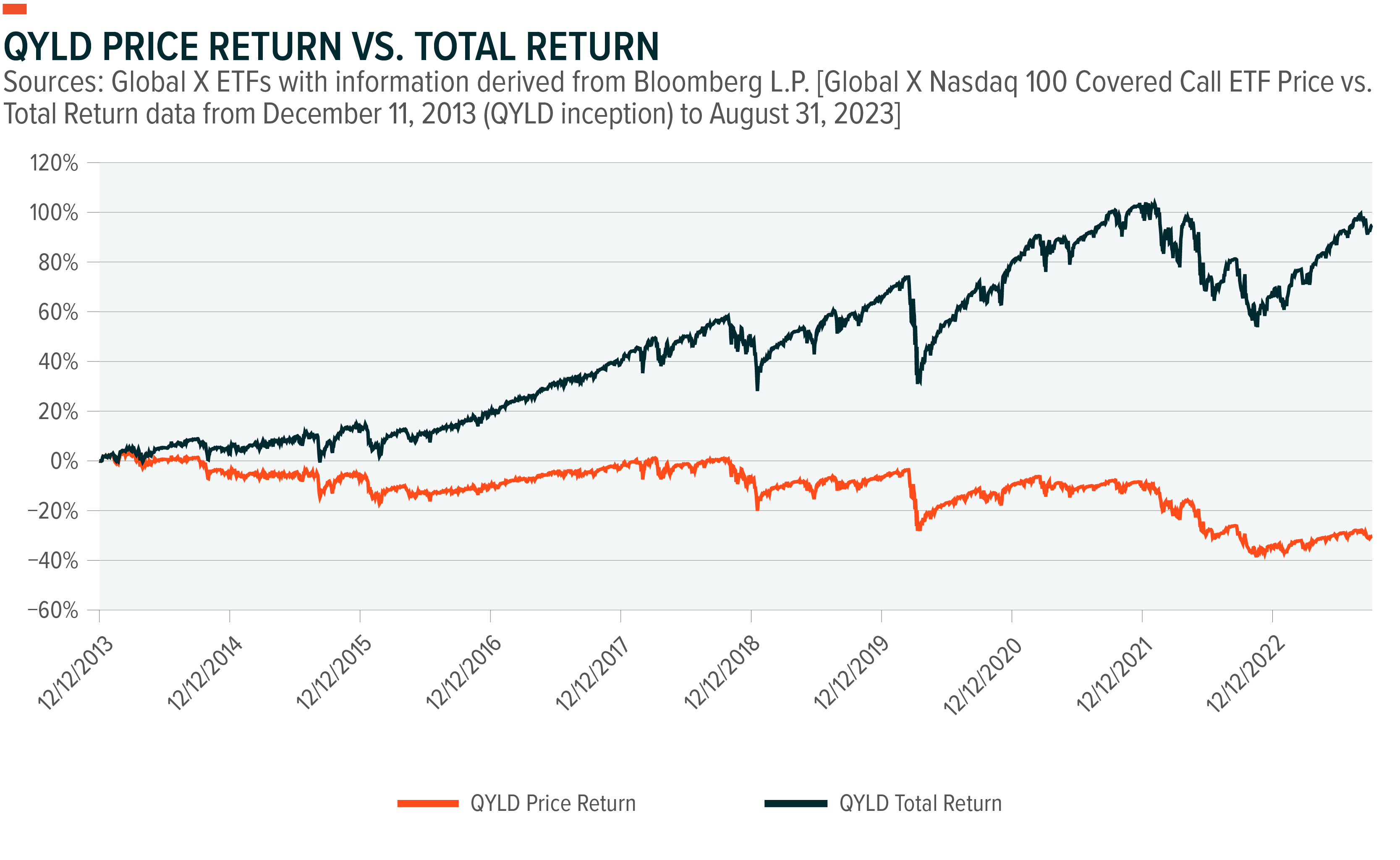
Past performance is not a guarantee of future results.
A natural question is how the fund can maintain recent price levels or recuperate its NAV after distributions. First, the fund reinvests the balance of the premiums that are not distributed to its shareholders. Second, new shareholders can help buoy the fund’s stockpile of assets. Third, the fund can derive value from the options that it writes, benefiting from changes in underlying time value.
For instance, when QYLD commences a monthly roll period, it writes a call contract that will fluctuate in value until expiration. These fluctuations take moneyness, volatility, and supply and demand into account. If the initial contract was written when volatility was elevated, and then volatility declined, the value of the call option written generally decreases in similar fashion over the course of the roll period. Writing this call option for a value that was higher than its realized value at expiration benefits the fund, as the option expires unexercised, creating an inverse relationship between NAV and volatility.
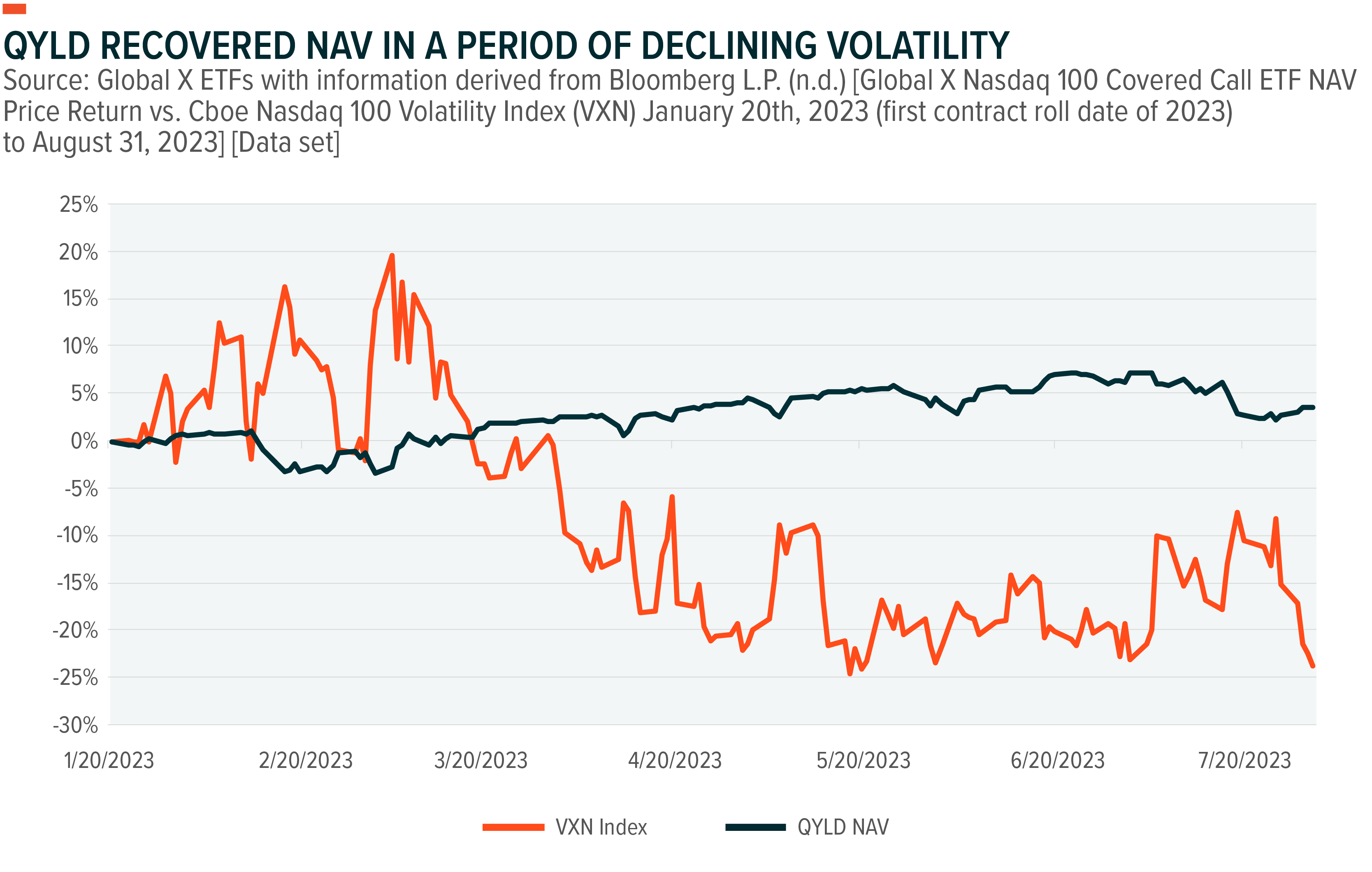
Based on the fund’s trailing 12-month yield of 11.89%, QYLD has shown it can remain competitive versus other asset classes from an income perspective even amid a period of declining volatility such as this.3 The income component may suit the needs of various accounts, including retail investors on the cusp of retirement or institutional cases like pension funds and endowments. That said, writing call options against 100% of an underlying portfolio can affect a fund’s performance in varying market scenarios. In theory, the premiums that QYLD receives position it to outperform the Nasdaq 100 most effectively when the index trades in choppy, flat, and declining directions.
Covered Call Strategies Can Help Investors Round Out Their Portfolios
Investors can pursue wealth generation in many ways, beyond traditional allocations like the 60/40 equity and fixed income structure. A strategy like QYLD can offer investors a potential stream of current income and a diverse group of holdings on which to base its risk-adjusted returns. With a portfolio that follows the rules set forth by the Cboe Nasdaq 100 BuyWrite v2 Index and daily disclosure of portfolio holdings, QYLD also allows investors to be fully aware of the fund’s exposures. The fund trades the upside potential associated with its reference equity index to create premium income, so it may also act as a functional portfolio diversifier and hedged equity solution on multiple levels.
Diversification Potential
Operating within the ETF sleeve, covered call option strategies like QYLD have the potential to reduce the beta coefficient associated with a basket of investments like the Nasdaq 100. Index funds can inherently provide this because they typically take positions on a broad base of assets. With more than $327 billion in global ETF and mutual fund assets that can be linked to it, the Nasdaq 100 is a popular destination for investors pursuing this exposure.4
When it comes to conventional income accounts that have more of a tendency to seek out high dividend-paying stocks, as the chart below shows, QYLD offers allocations toward sectors that they might have deemed unsuitable. By seeking to monetize the volatility associated with these sectors, QYLD’s ability to acquire premium income creates an opportunity to pursue these underexposed positions.
Visibility and Risk Mitigation Potential
Another key attribute associated with systematic covered call funds like QYLD is their straightforward, rules-based nature. Passively managed products typically follow a strict set of rules that establish specific exposures over an explicit time frame. Relative to a strategy that employs active management without daily holdings disclosure, this might empower investors to gain a better understanding of precisely where fund allocations are being made. The uniformity of a rules-based investment strategy can allow for seamless implementation into a broader portfolio, where risk-adjusted return metrics can be considered and weighed accordingly. It can also help to save the time that researching more complex strategies can require.
Ability to Work Within an Equity Growth Portfolio
Because QYLD seeks a minimal level of capital appreciation in exchange for option premiums, the fund offers a value proposition that can be utilized through various allocation combinations. For example, an investor may be able to implement QYLD within a broader growth portfolio as a means to obtain a growth and income blend, depending on their risk and yield appetite. The ability to be this nimble within an index tracking strategy that maintains a 100% coverage ratio with NDX call options can support an investors ablity to modify their respective portfolios in a variety of different ways. Some examples of equity portfolio breakdowns that harness QYLD are illustrated below.
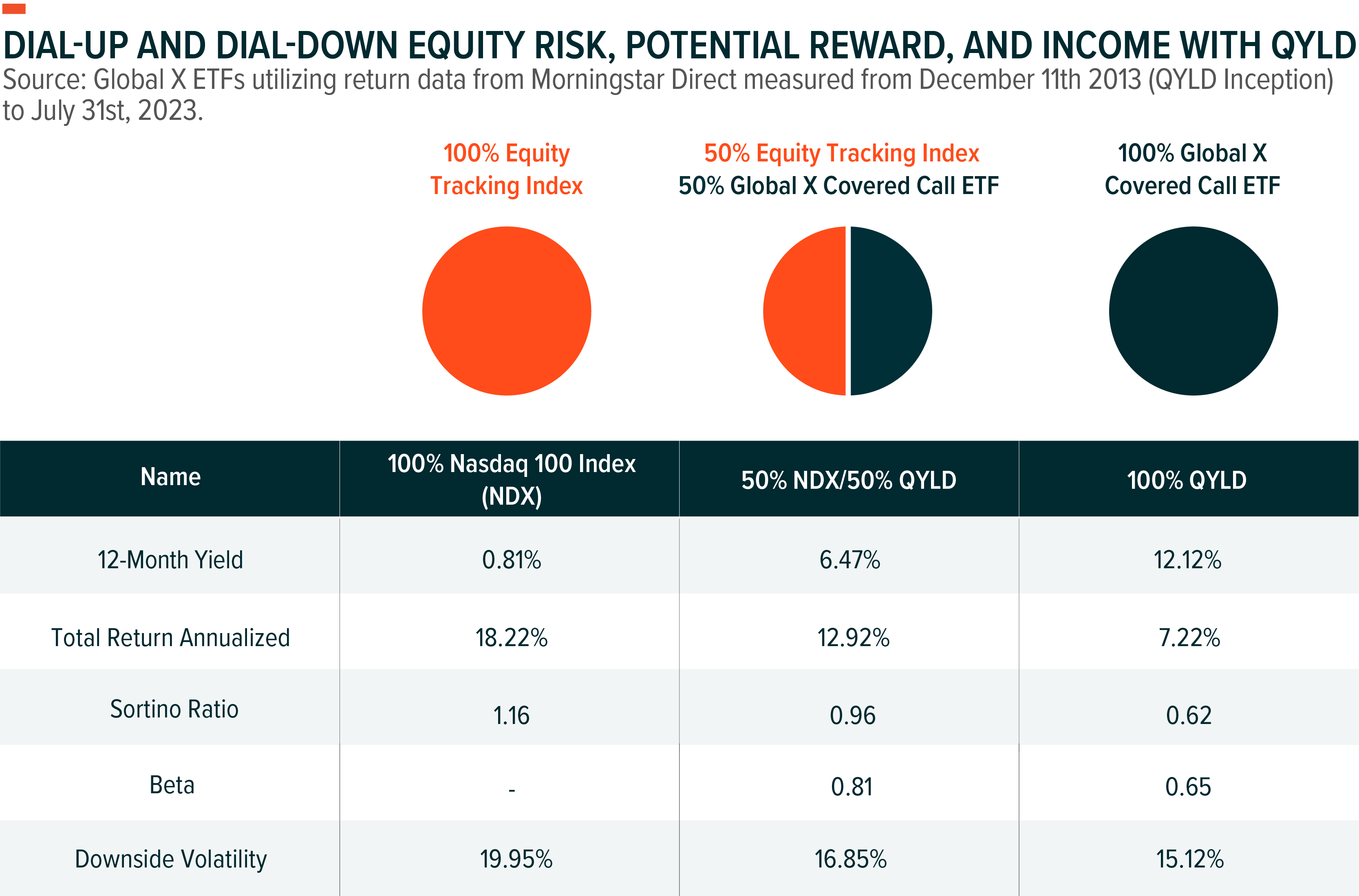
QYLD returns are represented by NAV returns. Beta is measured against the Nasdaq-100 Index.
The performance data quoted represents past performance. Past performance does not guarantee future results. The investment return and principal value of an investment will fluctuate so that an investor’s shares, when sold or redeemed, may be worth more or less than their original cost and current performance may be lower or higher than the performance quoted. Performance current to the most recent quarter- and month-end is available here.
Conclusion: A Multipurpose Premium Income Solution Amid Uncertainty
Mixed economic signals, including those from corporate earnings and treasury yields, make speculating on future market movements particularly difficult. This year’s rapid run-up in value for the Nasdaq 100 and its subsequent slowing doesn’t make it any easier. In this environment, covered call options strategies can bring a multitude of benefits to investor portfolios, particularly when volatility ramps up and uncertainties linger. As a core competency of the passively managed ETFs that Global X provides, we believe that QYLD’s systematic approach makes it a compelling income-generating diversification tool for a broad range of accounts.
Related ETFs
QYLD – Global X Nasdaq-100 Covered Call ETF
Click the fund name above to view current holdings. Holdings are subject to change. Current and future holdings are subject to risk.
 Robert J. Scrudato
Robert J. Scrudato